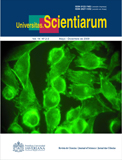Abstract
Objetivo. Identificar y caracterizar levaduras pigmentadas aisladas de ambientes naturales del Ecuador que sean productoras de metabolitos de interés para la industria y puedan ser utilizadas en posteriores aplicaciones biotecnológicas. Materiales y métodos. Se trabajó con 26 aislados pigmentados de la Colección de Levaduras Quito-Católica (CLQCA) que fueron sometidos a pruebas fisiológicas y moleculares para su caracterización, tipificación e identificación. Se evaluó la capacidad de asimilación de azúcares. Se emplearon las técnicas moleculares RFLP-ITS, MSP-PCR, amplificación parcial del segmento 26S del ADNr y secuenciamiento para identificación a nivel de especie. Se incubaron todos los aislados a 20, 30 y 37°C para determinar la temperatura en la que presenten mejor crecimiento. Posteriormente, fueron determinadas las curvas de crecimiento para cada aislado. Resultados. Se identificaron las especies: Rhodotorula mucilaginosa, Rhodosporidium babjevae, Sporidiobolus ruineniae, Rhodotorula glutinis, Rhodotorula slooffiae y una especie nueva del género Rhodotorula. Conclusiones. Se seleccionaron como cepas promisorias para futuros usos industriales los aislados de Rhodotorula mucilaginosa (CLQCA-12-013 y CLQCA-12-008) y Rhodosporidium babjevae (CLQCA-10-188), por presentar características de crecimiento rápido, alta asimilación de azúcares, producción de biomasa e intensidad en la pigmentación.
Palabras clave: levaduras pigmentadas, tipificación molecular y fisiológica, curva de crecimiento.
Abstract
Characterization and identification of isolates of carotenogenic yeast strains from several natural zones of Ecuador. Objective. To identify and characterize pigmented yeasts isolated from natural environments in Ecuador, producing metabolites with industrial importance and with potential use in further biotechnological applications. Materials and methods. Twenty-six pigmented isolates from the “Colección de Levaduras Quito-Católica” (CLQCA) were exposed to physiological and molecular tests for their characterization, typification and identification. Sugar assimilation ability was evaluated. Molecular techniques such as ITS-RFLP, MSP-PCR, partial amplification of the segment 26S of the rDNA, and sequencing were used for their identification at the species level. Growth curves for each isolate according to their specific optimum growth temperatures. Results. The following species were identified: Rhodotorula mucilaginosa, Rhodosporidium babjevae, Sporidiobolus ruineniae, Rhodotorula glutinis, Rhodotorula slooffiae, as well as a new species of the genus Rhodotorula. Conclusion. Rhodotorula mucilaginosa (CLQCA-12-013 and CLQCA-12-008) and Rhodosporidium babjevae (CLQCA-10-188) isolates were selected as promising strains for industrial applications, because they showed characteristics such as rapid growth, high assimilation of sugars, biomass production, and pigment synthesis.
Key words: pigmented yeasts, molecular and physiological typification, growth curve.
Resumo
Caracterização e identificação de isolados de leveduras carotenogénicas de diferentes áreas naturais do Equador. Objetivo. Identificar e caracterizar leveduras pigmentadas isoladas de ambientes naturais do Equador, que produzem metabólitos de interesse para a indústria e podem ser usadas em subseqüentes aplicações biotecnológicas. Materiais e métodos. Trabalhou-se com 26 isolados pigmentados da Coleção de Leveduras Quito-Católica (CLQCA) que se submeteram a provas fisiológicas e molecular para sua caracterização, tipificação e identificação. Foi avaliada a capacidade de assimilação de açúcares. Foram utilizadas as técnicas moleculares RFLP-ITS, MSP-PCR, amplificação parcial do segmento 26S do ADNr ribossomal e seqüenciamento para sua identificação em nível de espécie. Determinaram-se as curvas de crescimento para cada isolado de acordo com a sua temperatura ótima de crescimento. Resultados. Foram identificadas as espécies: Rhodotorula mucilaginosa, Rhodosporidium babjevae, Sporidiobolus ruineniae, Rhodotorula glutinis, Rhodotorula slooffiae e uma nova espécie do gênero Rhodotorula. Conclusões. Foram selecionados como cepas promissoras para futuros usos industriais os isolados de Rhodotorula mucilaginosa (CLQCA-12-013 e CLQCA-12-008) e Rhodosporidium babjevae (CLQCA-10-188), por apresentar características de crescimento rápido, alta assimilação de açúcares, produção de biomassa e síntese de pigmentos.
Palavras-chave: leveduras pigmentadas, tipificação molecular e fisiológica, curva de crescimento.
Univ. Sci. is registered under a Creative Commons Attribution 4.0 International Public License. Thus, this work may be reproduced, distributed, and publicly shared in digital format, as long as the names of the authors and Pontificia Universidad Javeriana are acknowledged. Others are allowed to quote, adapt, transform, auto-archive, republish, and create based on this material, for any purpose (even commercial ones), provided the authorship is duly acknowledged, a link to the original work is provided, and it is specified if changes have been made. Pontificia Universidad Javeriana does not hold the rights of published works and the authors are solely responsible for the contents of their works; they keep the moral, intellectual, privacy, and publicity rights. Approving the intervention of the work (review, copy-editing, translation, layout) and the following outreach, are granted through an use license and not through an assignment of rights. This means the journal and Pontificia Universidad Javeriana cannot be held responsible for any ethical malpractice by the authors. As a consequence of the protection granted by the use license, the journal is not required to publish recantations or modify information already published, unless the errata stems from the editorial management process. Publishing contents in this journal does not generate royalties for contributors.



